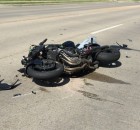Compared to other road accidents, crashes involving motorcycles are deadlier due to the minimal safety features found on bikes. In addition, poor visibility by other road users and vulnerability to weather conditions make riders more prone to accidents.
While technology has come a long way in reducing motorcycle accidents over the years, the human element contributes to a significant proportion of these crashes. Let’s look at the common types of motorcycle accidents you should know about and what to do after being involved in one.
Lane Splitting
Lane splitting is riding between lanes of stopped or slow-moving traffic flowing in the same direction. Most riders do this to bypass congestion and save travel time. While it’s illegal in most states, lane splitting is quite common, and among the main causes of motorcycle accidents across the country.
The main reasons for lane splitting crashes are poor visibility by other motorists and the lack of reaction time due to the proximity of vehicles in such accidents. The fault for a lane-splitting accident may fall on either party depending on the state laws, among other factors.
Intersection Accidents
Ignoring traffic signs, especially at intersections, is a recipe for disaster and a leading cause of motorcycle crashes. Such accidents account for nearly half of all motorcycle accidents, and given that they mainly involve other vehicles, most of them are fatal.
Human error is the leading cause of motorcycle intersection accidents. This mostly occurs when a rider or driver fails to yield to oncoming traffic.
Road Hazards and Hitting Stationary Objects
Motorcyclists are more vulnerable to road hazards than closed vehicles. Such risks may include potholes, gravel on roads, and uneven or wet road surfaces. All these hazards can cause a rider to lose control.
Crashing into stationary objects is also a common hazard you face as a rider. However, compared to closed cars, hitting an object while on a motorcycle is more dangerous, given that you may even be thrown off the bike.
Speeding Accidents
Speeding accidents often involve high-performance motorbikes and careless riding. About a third of all motorcycle accidents are attributed to speeding, with most of these crashes being fatal.
Avoid excessive speeds, especially when taking curves or under poor weather conditions. It’s risky, and in the end, it might cost you more time than you were trying to save.
Rear-End and Head-On Collisions
Rear-end and head-on collisions involve direct impact with another motorist. The severity of injuries on a rider in these collisions depends on the speeds involved and whether you were wearing safety gear. On most occasions, motorcyclists stand a higher chance of injury compared to closed vehicle occupants.
What Next After a Motorcycle Accident?
If you have been involved in a motorcycle accident, the most important thing to do is seek medical attention and keep records. Some internal injuries may not be noticed right away, so it’s crucial to get checked.
Afterward, contact the authorities to get formal documentation of the accident and report all injuries sustained in the crash. If possible, get statements from bystanders who witnessed the accident, as well.
Do Not Talk to an Insurance Company Before Your Attorney
Inform your insurance company immediately and do not engage in negotiations with anyone. Insurance adjusters from the party at fault may seek to get a formal statement from you, which can take away from your case. As such, you should not disclose anything regarding the accident without consulting your attorney first.
Remember, laws vary from state to state. For instance, Texas has a two-year statute of limitations beyond which you cannot pursue injury claims against the at-fault party. In addition to other laws surrounding such accidents, a reputable injury law firm in Austin will ensure that you are adequately compensated for your injuries.
